Tag: Royalties
The Australian Parliament has taken a big first step towards greater Aboriginal control over the 1.3 billion dollar Aboriginals Benefit Account, following a decades-long campaign by Aboriginal Territorians and their elected representatives.
The passing of the Aboriginal Land Rights (Northern Territory) Amendment (Economic Empowerment) Bill 2021 means that, for the first time, an Aboriginal-controlled body will make decisions about the ABA, which distributes the equivalents of royalties generated by mining on Aboriginal land in the NT.
“The ABA funds were always intended to benefit our people and it’s high time that they get to decide how they want to drive their own development with this income,” Central Land Council chief executive Lesley Turner said.
Since the inception of the land rights act in 1976, federal Aboriginal affairs ministers have been free to take or leave the advice of an ABA advisory committee made up of elected members from the four NT land councils.
Many of them did just that, with former ministers Mal Brough and Nigel Scullion two notable examples.
“I commend the current Minister for Indigenous Australians, Ken Wyatt, for breaking with this tradition and for also supporting the removal of Howard era amendments of the land rights act that were designed undermine the land councils,” Mr Turner said.
“We strongly opposed the devolution of land council functions following the NT Emergency Response, and while the provision has proven ineffective we’re glad to see the back of it.”
A new NT-based commonwealth corporate entity, the NT Aboriginal Investment Corporation, will make decisions about ABA grants and investments when it has been established.
Between now and next June, the corporation’s interim board will meet, hire an acting chief executive, form an investment committee and set up the corporation.
It will have a 12-member board comprising two elected representatives from each of the NT’s land councils, two independent directors appointed by the board and two independent directors appointed by the Australian Government.
It will receive $500 million, roughly half of the current balance of the ABA, plus $60 million annually for the first three years of its operation.
“We look forward to the corporation getting off to a strong start and, in time, assuming control over the remaining funds in the ABA, which can now be invested strategically,” Mr Turner said.
1 December 2021
Background
Papunya is a community 225km west of Alice Springs with a population of approximately 515 people. The CLC’s community development unit conducted consultations and planning sessions with the community between 2013 and 2015 to develop governance arrangements, including a community development working group, and determine what community benefit programs and projects residents would like to allocate their funds to. The community chose a working group to prioritise and plan community benefit projects and in March 2014 it delegated power to the working group to authorise expenditure on completed project plans.
After establishing these governance arrangements, Papunya decided to allocate its initial five year lease money and a small amount of its section 19 lease money income to undertake community benefit projects with the support of the community development unit. From 2012 to 2016 the community allocated $817,450 to 12 community benefit projects which included upgrades to community sporting facilities, improvements to the community store and community transport for health and cultural activities. The community development unit also consulted with residents about compensation income known as the Surprise Well oil affected areas money in 2015 and 2016.
Community members have acknowledged that project governance can be challenging due to competing community interests. The working group initially managed this by funding smaller, less sustainable initiatives, but found it difficult to implement more significant community benefit projects. Between 2016 and 2019 traditional owners decided to distribute most of their lease money to individuals rather than allocate it to projects.
Matched funds trial
At a community meeting in October 2020, however, traditional owners decided to allocate 80 per cent of their community lease income (around $80,000 per year) for the next three years to community benefit projects and to distribute only the remaining 20 per cent to individuals. A significant reason for this reversal was a matched funds trial that sees the income the community allocates to community projects matched dollar-for-dollar by the National Indigenous Australians Agency, thus effectively doubling Papunya’s yearly income for community development projects for three years.
Through this decision, Papunya traditional owners allocated $458,550 section 19 lease money through the CLCs community development program, which was matched with $458,550 matched funds, making a total of $917,101 available for projects. The matched funds program is approved by the Minister for Indigenous Australians from the Aboriginals Benefit Account (ABA).
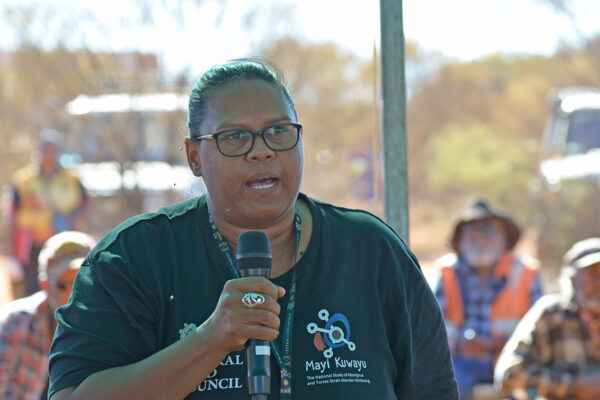
Community members confirmed that the trial was the incentive they needed to allocate the majority of their lease income to community development projects.
“There was a diagram and [CLC staff] explained it. I think it’s good from the government to give us that money…because in our case it’s a lot of money…we looked at it and we actually seen that it was a lot of money because we got it yearly for three years,” working group member and CLC delegate Lynda Lechleitner, (pictured right) said.
The CLC community development team continue to facilitate governance group meetings and consultations with the Papunya community development working group. Community consultations have become increasingly important in the CLC’s work as they allow in depth discussions about projects, governance and associated matters in a less formal setting. They also support the capacity building of individual working group members.
The community increased, diversified and rejuvenated the membership of its working group in 2020 which reflects significant recent changes in Papunya that have seen new younger leaders such as Ms Lechleitner emerge. She described the new dynamic as “the community actually being more open-minded and listening to others”.
“Now there is not just one person speaking. It’s a collective. There are a lot more people thinking ‘that will be a good idea’ or ‘that won’t be a good idea’. You get more discussions,” she said.
Papunya working group member and CLC delegate Terence Abbott said this of the progress that the working group is making; “I just want to see things happen instead of people coming up and down with the same old story. If other people are happy then I’m happy too.”
Working group members now have strong ideas about the future development of their community and want to take full advantage of the opportunity to plan projects with the increased income available through the matched funds trial. Terence Abbott would “like to see a lot of changes with this community”.
“I have been a ranger here since 2010. I was the first one to put my hand up back then. I’d like to see opportunities with tourism [and] fixing up our outstation so we can create employment for our young people,” he said.
At their latest meetings, the governance group continued to move forward with planning and funding their community priorities. In 2021 and 2022, Papunya allocated almost $300,000 of their Matched Funds to two significant community infrastructure projects that community members – through their governance group – identified as a priority: building ablutions at the Papunya sorry camp site and developing shaded community picnic and BBQ areas within the community.
These projects are highly valued as Lynda Lechleitner outlined. “A picnic area for everyone, like even people that are travelling through, so they have actually got somewhere to sit and take a breath before they move on again…projects that are something that the community values”.
The working group has chosen Ranger Works to implement the picnic area project, a fee for service initiative of CLC that prioritises local Aboriginal employment for small scale infrastructure projects.
Ms Lechleitner, from the Town Bore outstation near Papunya, hopes that the community development program will continue to empower her community, “It’s more or less trying to give people a voice and an understanding of what direction they can spend their money in, as a community leader, to better this community. It’s taken a long time for the community to get to where they are now, to tell [the government] what they want as a community.”
“My vision is to get a healthier community where everyone can speak up and be stronger for the community,” she said.
Update February 2023
CLC staff undertook 12 consultations with Papunya’s community development working group members between July and December 2022.
The consultations were part of a process to finalise the picnic area and sorry camp upgrade projects funded by the community’s matched funds and aimed to ensure that residents were involved in the contract and project management.
Working group member Linda Allen said it was important that all working group members can take part in the project development and decision making throughout.
“What is working is [CLC staff member] going around and sitting down and talking to people. It’s a follow-up thing, it’s good. It’s everybody making decisions. When somebody comes up with a good idea [CLC staff members] don’t just go and do it straight away, they are always asking and checking everyone’s opinion,” she said.
The picnic area and sorry camp upgrade projects are due to get underway in 2023, following the execution of contracts with project partners in December 2022.
The Papunya community development working group wants to continue to plan new projects from their priority list.
Update August 2024
Throughout 2023, CLC staff worked closely with governance group members and contracted partners to plan and deliver the ablution facilities at the community sorry camp and community barbeque picnic facilities.
The picnic facilities were completed in August 2023 and the sorry camp ablutions were completed in March 2024.
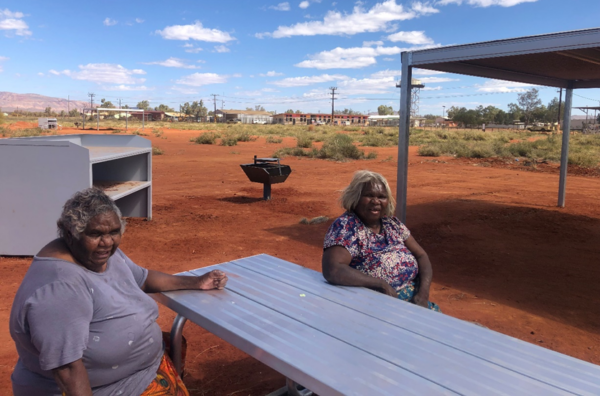
Governance group member Punata Stockman is proud the picnic area project came from a community idea and involved community employment. “I feel happy and proud that it’s happened,” “It’s an Anangu idea, so all Anangu can be happy.” Ms Stockman said.
A younger and very active governance group member, Sarah Stockman explains that despite some frustrations with completion timelines associated with infrastructure projects in remote central Australia Papunya is now able to use these facilities designed, planned and funded by their community. “I’ve lived in Papunya most of my life and I am involved in the working group…It’s just better being in the sorry camp… staying there cause it’s got the toilets and showers…everything that they need there…instead of out into the outskirts of the community where they have to build their own shelters…and the picnic areas are looking really good…they’ve got a barbecue plate, shelters and tables as well where they can actually put their stuff on the tables you know for the cooking and somewhere to sit as well.”
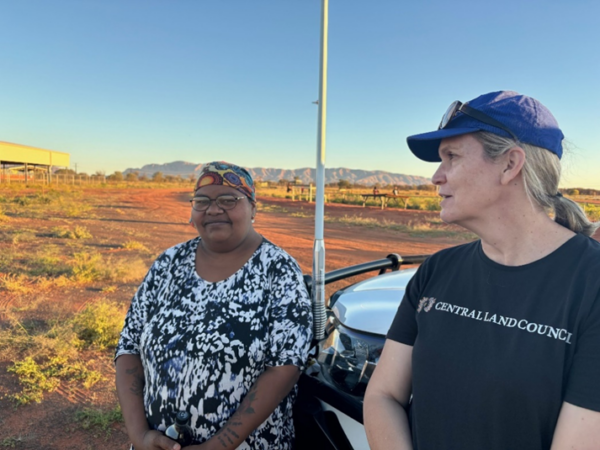
In April 2023, the community also funded a masterplan project. The community will work with remote planning experts to design four playgrounds and an outdoor gym and to investigate community greening and water harvesting options.
The community funded this planning project with the aim of ensuring community can comment on the various aspects of the project and have ownership of the design elements. They also hope it can improve contracting and construction timelines for future community project allocations.
Multiple community consultations on the masterplan project have occurred so far, including trips to Papunya with the CLC and the project partner to consult with community members and stakeholder organisations. A range of community stakeholders are involved in the planning, making it a collaborative process for the aspirations of community members in their development of Papunya.
It is expected that the masterplan will be completed by the end of 2024.
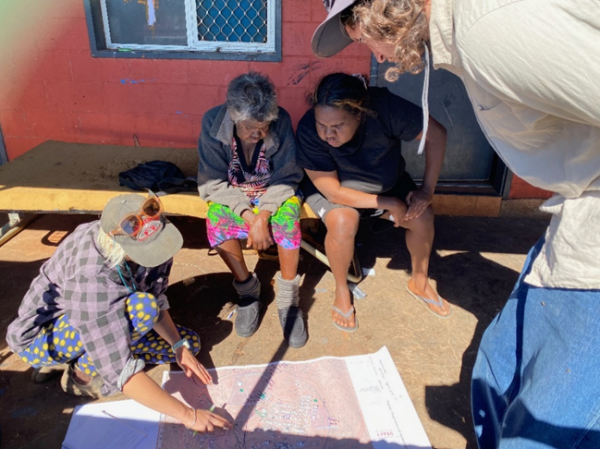
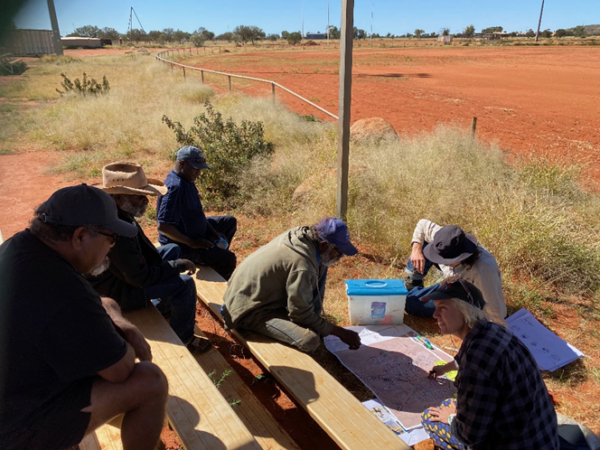
Photos: Landscape architects consult with Papunya community members and community development working group members about the masterplan
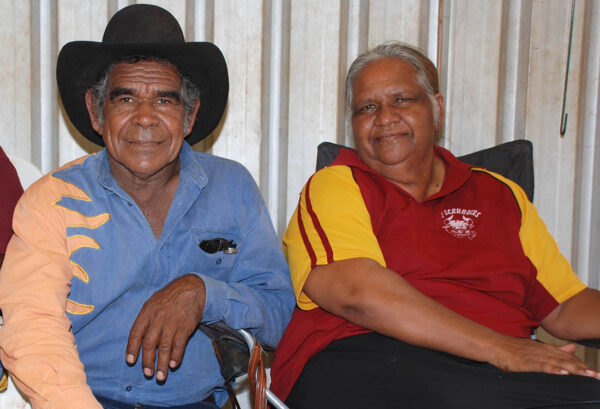
Shirley Dempsey (pictured right) knows the benefits of very remote outstation living. But she also knows the big risks. In recent years, now 64-year-old Ms Dempsey collapsed and had to be flown to Adelaide. Fortunately she was in Alice Springs at the time.
But the timing might have been bad. She might have been at home, nearly 540 kilometres away at her outstation Urlampe, 30 kilometres from the Northern Territory-Queensland border as the as the crow flies, off the unsealed Plenty Highway, and arguably closer to Mount Isa.
So Ms Dempsey and her partner Alan Rankin decided to devote all the $150,000 allocated to their outstation in the Aboriginals Benefit Account outstations project to upgrading their airstrip so it’s Royal Flying Doctor ready.
Other outstations, such as Walka, equally remote in the opposite direction, near the Northern Territory-Western Australia border, south of Kaltukatjara (Docker River), will support their small scale tourism enterprises with the same allocation. Most welcome the funding opportunity to simply make ultra-remoteness more liveable, such as Brumby Plains outstation where resident Desley Rogers is a director of the surrounding successful Mistake Creek Aboriginal-owned cattle station. The station is much closer to Kununurra in Western Australia’s Kimberley region than to Alice Springs.
With about one-third of its $150,000 allocation, Brumby Plains has upgraded its telecommunications to a system allowing mobile telephony and internet access. “With that up and running now, it’s really good,” says Ms Rogers. “I can do a lot of things on my mobile, like check my emails. It’s really good.” Like Urlampe’s airstrip, Ms Rogers also fully appreciates the safety implications of much better communications in such remote circumstances.
The 105 outstations, also known as homelands, in the Central Land Council area each given the chance to receive the $150,000 have the CLC executive to thank for initiating the ABA outstations project. The committee lobbied the Australian Government hard to have $15.75 million provided to outstations in the CLC area from the ABA. The same went to outstations in the Northern Land Council area, and smaller amounts to those in the NT’s two smaller land council areas.
The ABA receives from the government the equivalent amount paid to the government in royalties from mining on Aboriginal land in the NT, for the benefit of NT Aboriginal people. The ABA advisory committee comprised of representatives of the NT’s four land councils makes recommendations to the federal Minister for Indigenous Australians, Ken Wyatt, who ultimately decides on ABA grants. Then it’s usually over to the grantees to do what’s specified in the grant agreement.
The ABA outstations project has involved additional governance and project management complexities, handled in different ways by the different land councils.
The CLC had to find a fair and transparent way to choose the 105 outstations to potentially receive the funding out of the 309 total outstations in the CLC area. If the $15.75 million was shared among all 309 the resulting works wouldn’t have been worth doing. And a fair, clear and comprehensible way of spreading the 105 around the CLC’s nine regions had to be found, considering some regions have many more outstations than others. The project could not initiate new outstations. The project is only for outstation upgrades, with the funding allocated only to those places passing the assessment criteria of need, benefit and capacity.
So, the CLC began the project by surveying as many of the 309 outstations in its area that it could, in regional information sessions with their residents or some-time residents. The survey covered a wide range of data, including existing outstation infrastructure and its condition, supports from service providers and residents’ employment. It has resulted in CLC’s first comprehensive, centralised spreadsheet of outstation data, long overdue, but already due an update to remain relevant and widely applicable to CLC’s various operations.
Summaries of the data, and recommendations based on the assessment criteria, were taken to a council meeting, where the CLC delegates chose the outstations in agreed numbers per sub-region to make up the 105. Fully briefed and integrally involved, they did so without dispute, though over 200 other outstations missed out on the funding entirely.
The CLC subsequently consulted at the chosen 105 towards detailed applications for each addressing the assessment criteria. At last count, the minister had approved 90 of these, with the remaining 15 held up by COVID-19.
Those approved go to the National Indigenous Australians Agency. The NIAA is charged with engaging suitable providers of the works at clusters of the approved outstations, ideally Aboriginal organisations hiring members of the outstations to do some of the work.
With the completion of all works, it is expected more than 100 Central Australian outstations will be better equipped as sanctuaries in the event of crises like COVID-19, indeed safer and more liveable for the Aboriginal residents on their country, crisis or not. Residents like Desley Rogers and Shirley Dempsey of remote Brumby Plains and Urlampe outstations respectively.
Update, 18 November 2022
By design with the CLC at its outset, this project as a whole is now the responsibility of the NIAA, with outstation providers at each of the more than 100 outstations to receive project support.
The CLC has not had responsibility for this project since fulfilling its role by November 2019. Yet it continues to receive inquiries from outstation residents about the project’s progress. It is directing them to call the NIAA on 1800 354 612.
The Wurrpujunta Anyul Mappu digital archive is literally a case of ancient Aboriginal culture meets state of the art digital technology, the Dreaming meets ‘the cloud’.
The archive is an initiative of Julalikari Council Aboriginal Corporation at its impressive Nyinkka Nyunyu Art and Culture Centre in Tennant Creek, 500 kilometres north of Alice Springs. The archive electronically and physically stores cultural and historical material of the many Aboriginal language groups in the Northern Territory’s Barkly region, centred on Tennant Creek.
At peak performance, as a tool of a living, dynamic yet ancient Aboriginal culture at the hands of more local Aboriginal people employed on it, the archive will increase and preserve that material, help transfer the cultural knowledge in it to the groups’ young, and educate the wider public, provided suitable access protocols are in place.
The archive needs Aboriginals Benefit Account funding to reach that potential, largely to modernise its software to a so-called cloud-based platform, better arrange metadata and the electronic archival material itself on this platform, and strengthen archive security while generating more and varied content and wider use. Julalikari is applying to the ABA for the necessary funding with the help of the Central Land Council’s ABA applications support project.
Enterprise and employment, education and training, sport, health and safety, language and culture, land care and land management, building and other infrastructure, media, leadership and youth initiatives are all eligible for ABA funding.
An initiative planned at Arlparra, 250 kilometres northeast of Alice Springs in the Sandover/Utopia region, combines health and safety with sporting infrastructure works, for instance. A horse program at Ltyentye Apurte (Santa Teresa), 85 kilometres southeast of Alice, offers pathways for school students into land and animal management. And the Aboriginal organisations behind these initiatives too have requested the CLC’s ABA applications support project help towards the strongest possible applications to the ABA.
Julalikari director and Nyinkka Nyunyu steering committee member Michael Jones Jampin said that before the digital archive traditional ceremony recordings and those of more public dances were stacked up there in cupboards and drawers. “It wasn’t good that way,” he said. “The archive is the way of keeping everything safe for our next generations.”
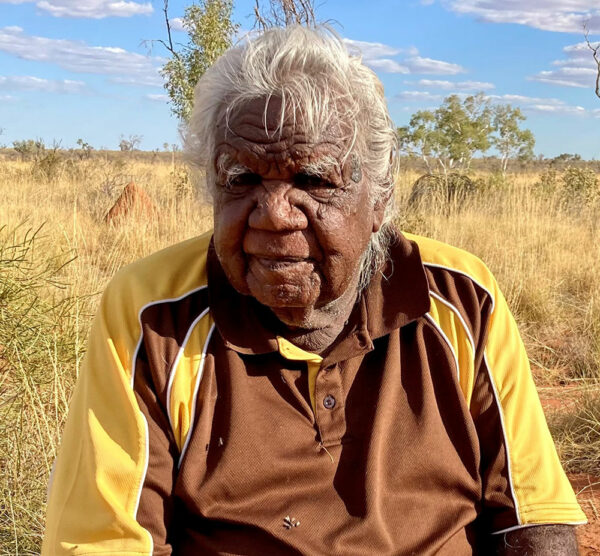
So what did Mr Jones (pictured right) think of the workshop project held with him and others on the steering committee to kick off its help with the archive upgrade application?
“It went good, very well. Helpful,” he said. “A lot of people were saying that was very good.”
The ABA receives from the Australian Government the equivalent amount paid to the government in royalties from mining on Aboriginal land in the NT, for the benefit of NT Aboriginal people. The ABA advisory committee, comprised of representatives of the NT’s four land councils, makes recommendations to the federal Minister for Indigenous Australians who ultimately decides on ABA grants.
The CLC’s ABA applications support project started because the ABA was receiving too many weak or incomplete applications that didn’t meet the minister’s approval, or didn’t even get that far. So, otherwise good Aboriginal initiatives didn’t get funded and the ABA hasn’t benefited as many Aboriginal people as it should have.
The project now gets more requests for assistance than it can handle thoroughly, requiring considerable expectation management with potential applicants and CLC staff alike. The project looks to help those who request it first in each of the CLC’s nine regions, towards a variety of initiatives that require the help and the funding most and that benefit the most people, in Aboriginal organisations who have the ability to manage the funding and make sure their initiative succeeds and lasts if funded. These are the main, but not the only, considerations brought to bear to decide which ABA applications to assist among the many seeking assistance.
Typically the project’s two personnel spend hours with the assisted ABA applicants, workshopping the application assessment criteria of need, benefit and capacity, each initiative’s risk management, the keys to making the initiative last and the documents required to support the application. Then they draft the applications and some supporting documents and stay in touch with the applicants until submission time. Though they give it their best, they don’t do all the work; and they provide no guarantee of funding.
Since starting in earnest in mid-2020 (after six months of COVID-19 restrictions), the project has helped 15 applicants with ABA applications, across eight of the nine CLC sub-regions. Some disengage entirely from the help for their own reasons or because, despite the help, the ABA application process remains a long and difficult one. That is in turn largely because the application guidelines are in dire need of revision.
As part of its ABA applications support project, the CLC has spent considerable time advising the National Indigenous Australians Agency on better guidelines; and in fact has effectively provided two re-drafts.
With clearer, more accessible application guidelines reflecting a more user-friendly and transparent ABA application process, the CLC’s application support may one day no longer be needed. Meanwhile, it is assisting as many applicants as it can towards more sustainable initiatives to benefit Central Australian Aboriginal people. Initiatives like Julalikari’s Wurrpujunta Anyul Mappu digital archive, using hi-tech in the service of ageless Aboriginal traditions.
Update, 18 November 2022
The CLC’s ABA Applications Support Project has received 81 requests for application support from its start in 2020 to November 2022. It has assisted 26 applications across almost all eligible activities and the CLC’s nine regions. Eighteen assisted applications have been submitted to the ABA, worth a total of $38.1 million. Of these, seven have been approved for funding for a total of $4.8 million, three were unsuccessful and eight are still being assessed. Project assistance to one further applicant resulted in funding through the CLC’s $36.7million ‘economic stimulus’ fund, a separate ABA-funded initiative (see https://www.clc.org.au/aba-economic-stimulus-package/).
The project has had to reject most requests for its support due to insufficient resources. Its part-time consultant project manager and single full-time project officer haven’t had time to give more applicants meaningful support. The project would have needed nearly three times the current personnel to fulfil all requests.
This is one lesson from the project. There are others.
Of the three supported unsuccessful applications, two in fact asked for and received minimal project support, suggesting support matters. The seven supported applications approved by the ABA to date received an average of $697,420 in funding each, nearly $100,000 each more than the total cost of the project. They represent a 70 per cent success rate for the project that, if maintained over the remaining eight applications for assessment, would bring an extra $23.3 million in total to the supported applicants combined.
In both current and projected calculations, the project represents very good value for money. It has proved a good investment.
Typically, the project’s support has been comprehensive and prolonged, constituting at least 50 per cent of the substantial work of each application, often more, over many months. It frequently starts with a long workshop with the applicant and builds some applicant capacity on the way towards funding. “We learnt very fast when drafting the application ideas,” a workshop participant surveyed for feedback said.
But the project never did all the work of applications, or else there was no such capacity building opportunity. Because of limited project resources, the capacity building was limited to that around the initiative proposed for funding, not the capacity of the applicant as a whole.
The project too often found this wider capacity patchy or stretched at best.
If eight of the 26 applicants assisted failed to ultimately submit their applications, this is a fair indication that nearly one-third of applicants’ capacity remains too weak to make the most of the project’s support to gain often much needed funds.
There are of course other dynamics at play here, some quite applicant-specific, and wider questions raised about organisational capacity to actually implement initiatives and acquit funding.
The ABA applications guidelines haven’t helped applicants to get funding in the first place.
Revised by the National Indigenous Australians Agency mid-way through the 2021-22 financial year, the guidelines emerged 39 pages long and a poor guide even to applicants with quite strong capacity and the project’s assistance. One said when surveyed: “Without you, I’m not sure we would have been able to get this across the line.” The guidelines may in fact have deterred some applicants entirely.
Hopefully, applicants are given much better guidance to apply to the Northern Territory Aboriginal Investment Corporation, the new body to take over ABA grant application, approval and payment processes.
It is likely some, perhaps many, applicants will still need assistance like that of the CLC’s ABA Applications Support Project. The project manager has suggested modifications to the project, including to help address the issue of some applicants’ incapacity to ultimately apply for funding despite project assistance.
This should further raise the already high value of this CLC project should it be continued, to bring yet more benefit to CLC constituents at comparatively low cost.
Traditional owners of the Yeperenye/Emily and Jessie Gaps Nature Park near Alice Springs will celebrate the official opening of their new public walking and cycling trail between Anthwerrke (Emily Gap) and Atherrke (Jessie Gap) on Wednesday, 28th July.
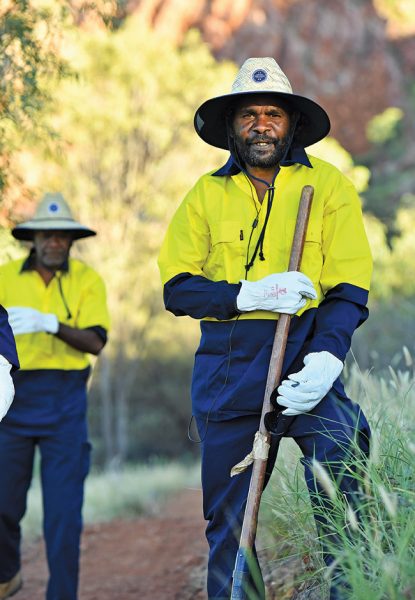
A smoking ceremony and dance at Anthwerrke [UN-door-kwa] at 10.30 am will be followed by an opportunity to experience the trail to Atherke [[ah-TER-ka] with families from the Amoonguna and Santa Teresa communities and lunch.
The $364,000 trail is the biggest investment in public infrastructure by any Aboriginal group in Central Australia.
The traditional owners used the rent income they get for the jointly managed park to pay for the trail because they want to raise awareness of the cultural significance of the area and create employment in trail design, construction and tourism.
More than 30 Aboriginal workers built the 7.2 kilometre trail by hand, receiving one-the-job training by local company Tricky Tracks.
Cultural supervisors were on site during the construction to ensure important sites were respected and protected.
Traditional owners also helped to design the trail which follows the contours of the East MacDonnell Ranges and will feature interpretive signage at the trail heads.
“I’m feeling really proud of this trail launch. We waited six years to do it and now it’s finally here. The families are really excited,” traditional owner Lynette Ellis said.
“Tourists should experience the East MacDonnell Ranges as well as the West Macs,” Grant Wallace, from Amoonguna, said.
Mr Wallace is a member of the traditional owner group that planned and funded the project with the help of the CLC’s community development program.
He was one of the workers who built the trail using hand tools, which minimises erosion.
“It has been good learning new skills and being able to work hard and share this sacred place with everyone,” said Mr Wallace.
“I’m looking forward to using these skills for future trail work around here.”
Wheelchair users can access the dual usage trail at both the Emily Gap and Jessie Gap ends and there is seating at rest stops.
“It’s so the old people and those who aren’t mobile can also come to the site,” Ms Ellis said.
The park is home to significant dreamings, the place where the three caterpillar songlines Yeperenye [Yep-ah-RIN-ya], Ntyarlke [n-CHAYL-ka] and Utnerrengatye [OOT-ner-ung-utch] intersect.
“The trail is an act of generosity by the traditional owners that will not only benefit local tourism, but also create employment on country,” said Central Land Council chief executive Lesley Turner.
“They have so much more to teach us all about their country and visitors are crying out for those experiences.
“We will continue to support traditional owners who wish to invest their collective income in sustainable projects,” he said.
The NT Parks and Wildlife Services will provide the interpretive signage and repair and maintain the trail.
